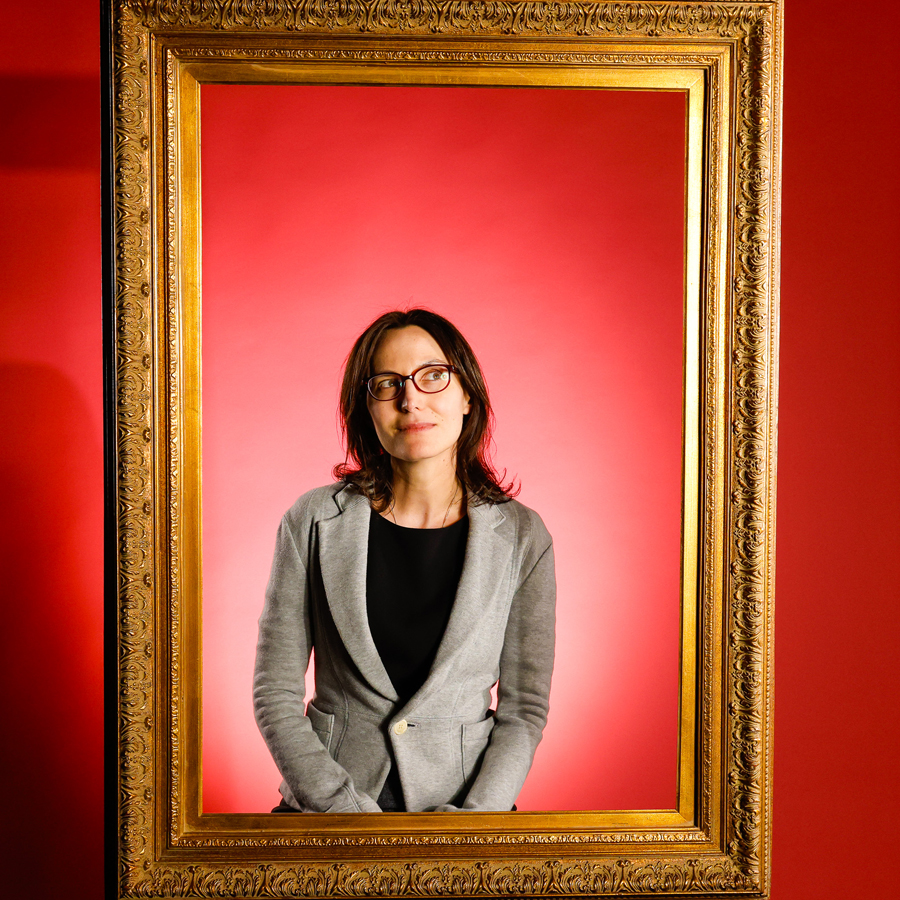THE NEW YORK-BASED SPECIALIST ON ILLUSTRATION’S GROWING POPULARITY, ITS IMPACT ON AMERICAN CULTURE AND WHY PIN-UP ART OFFERS MORE THAN MEETS THE EYE
Interview by Christina Rees • Photos by Josh David Jordan
Sarahjane Blum’s passion for illustration started early in her life and never let up; she grew up to be an internationally noted expert in the field. Over the past 20 years the New York City native has worked with Illustration Art in all of its marvelous incarnations – as a dealer, historian, curator and writer. The field is rich, and Blum knows the territory well: Golden Age, Mainstream Vintage, Sci-Fi, Pulp, Pin-up, Contemporary Illustration Art and beyond.
Blum recently joined Heritage Auctions’ New York office as Director of Illustration Art. Prior to that, she was the co-owner of Grapefruit Moon Gallery in Minneapolis, an innovative and leading player in the fields of Illustration Art and photography, and she co-authored the gorgeous Taschen outing The Art of Pin-Up, which illuminates Illustration Art greats including Alberto Vargas, George Petty and Gil Elvgren. Blum also appears in the new Bunny Yeager documentary Naked Ambition, currently on the festival circuit, to which she contributes her insight into the evergreen complexities and popularity of the legendary pin-up photographer.
Below, Blum talks spring auction highlights, the book that introduced her to Illustration Art and why Heritage continues to be a leader in the category.
Blum joined the Heritage Auctions team at the beginning of 2024.
How did you fall in love with illustration?
I wouldn’t have known what to call it when I was growing up, but I was always in love with illustration. I come from a very bookish family, and I grew up obsessed with Alice’s Adventures in Wonderland. My first copy was a 1980s version illustrated by an artist named Michelle Wiggins. Then one year for my birthday I was given a reprint of the original edition with the iconic line drawings by John Tenniel. I’d sit with them both comparing the worlds they built, letting them both into my imagination to influence my own vision of Wonderland.
But it wasn’t until I went to graduate school and started learning about the history of publishing and advertising in America that I began to understand how illustration functions in driving American culture. For example, when I say “Santa Claus” and you picture a jolly man in a soft red suit with a white beard, that’s largely because of the Santa advertisements an illustrator named Haddon Sundblom began creating in the 1930s for Coca-Cola.
Illustration Art continues to be exciting as one’s taste evolves, too, because it richly communicates a narrative moment and also builds and reflects larger cultural stories. Once I started to think about it in those terms, I realized I could look at it and think about it forever. Luckily, working at Heritage, now I get to.
Gil Elvgren’s ‘Your Choice – Me?’ from 1962 was published as a Brown & Bigelow calendar in 1964 and appears in the 2014 book ‘The Art of Pin-Up,’ of which Blum was a co-author. The work is available in Heritage’s April 23 Illustration Art auction.
Illustration is a fascinating “cross-category” art form. How would you define it, and how does Heritage capitalize on this phenomenon?
Illustration Art is art that was created for reproduction. When artists set out to create an illustration, they expect people to encounter the piece not hanging on a wall, but as an advertisement or calendar or as part of a comic, book or magazine, or on a record cover, a video game box or even a Pokémon card.
Heritage is unquestionably a leader in Illustration Art. As a company, we celebrate collectors, and we lead with passion. In addition to our Illustration Art department, which looks at the body of work to come out of the field of illustration as a whole, we often find original Illustration Art presented in sales alongside examples of its published usages. You’ll find Illustration Art popping up in all sorts of categories – everywhere from rare books to posters to comics to vintage Nintendo sales. And I love that Heritage introduces collectors to this unique original art in so many ways, and so often we find that once people discover it, they, like me, get hooked.
We’re always trying to put the pieces together of why people become passionate collectors and to invite them to engage with their passions in new ways. I came to my interest in midcentury paperback art because I was compelled by the original illustrations I encountered, and I know so many collectors who found themselves on the opposite journey – collecting originals they found of their favorite books. Understanding and respecting both journeys is, I think, why Heritage has become such a leader in Illustration Art.
Rudy Nappi’s cover for Jane Manning’s 1953 novel ‘Reefer Girl’ is another highlight in Heritage’s April 23 Illustration Art auction.
Why are we, as art lovers and collectors, still so compelled by these images today?
Illustration has been a highly competitive field throughout its history, so the sheer quality of so much of this work is remarkable. This is certainly apparent when we think about how many illustrators went on to successful fine art careers, like the Western artist John Clymer and, of course, the illustrators who have made their way into the canon of 20th-century art, like Norman Rockwell.
Illustration Art also, as I mentioned, offers so many ways into thinking about it. And like so many forms of art, it rewards that sort of deep exploration. I’ve worked with pin-up art for almost 20 years, and I’m aware that it’s not everyone’s cup of tea. People sometimes write it off as one-note, with the various depictions of conventionally beautiful women seeming interchangeable, but the more time I’ve spent looking at it the more I find myself fascinated. Not only is it incredible to have the chance to watch a given artist return to a favorite subject again and again, and be able to explore the development of their own style over time, but it also often offers unexpected commentary and insights into the moment it was created.
For all these reasons, I think we’re still seeing growth in the field, as people’s awareness of the availability of these works catches up with their interest in the imagery.
What are some of the highlights in Heritage’s April 23 Illustration Art Signature® Auction?
One of my favorite pieces in the auction is Your Choice – Me? by Gil Elvgren. It’s bright and sexy, of course, but it’s also a very funny take on the debate about abstract versus representational art, which is its own reminder that even though illustrators weren’t traditionally taken seriously by the art world, they were often in closer conversation with the trends in fine art than people gave them credit for.
We’re also offering the original cover art for the 1953 paperback Reefer Girl. The book is one of the most collectible pulp paperbacks around and one of the most famous offerings from the juvenile delinquent/drug culture subgenre. But it’s not just the provocative title or sensationalist story that made this book so desirable. It’s how the artist Rudy Nappi so thoroughly seduces the potential reader through the cover girl, making us unable to resist the invitation into her world of what would then be called depravity. Looking at the book, you feel the pull, but looking at the original art, you get to figure out why it’s so strong. The neon arrow, suggestively pointing down and also directing the eye to the bad girl at the center of the canvas, who seems lit from within – it all tells a story as powerful as anything in the book itself.
Sarahjane Blum can be reached at SarahjaneB@HA.com or 214.409.1549.
 CHRISTINA REES is a staff writer at Intelligent Collector.
CHRISTINA REES is a staff writer at Intelligent Collector.




